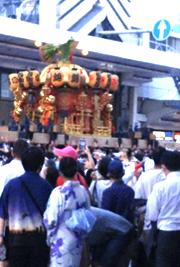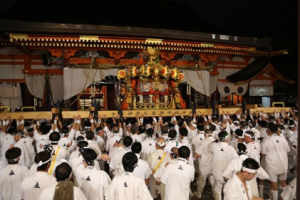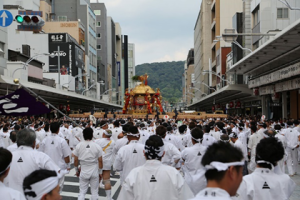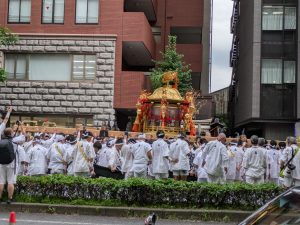Gion Festival in July
 |
 |

From Shijo Otabisho to Yasaka Shrine Photo taken on July 24, 2022 |
 The front of Otabisho Photo taken on December 24, 2024 |
Yoshie Doi
The Gion Festival is attractive for its contrasting dynamics and stillness, with the Yamahoko parade and mikoshi togyo on July 17th and 24th. The mikoshi of Matsuo Taisha Shrine is also chanted with a unique “hoit, hoit” sound. What is the meaning behind this “hoit” chant?
Whit whit. When we’re going well.
Yoisano. When we put it down.
Yoiyassaja. When we’re carrying it well.
Yoisaa, yoisaa. When we’re going slowly.
When carrying something, we often say “yoisho,” but about 20 years ago I read a document that said this was because when the gong from Kenninji Temple floated down the Kamo River and people were pulling it up, they shouted the name of Kenninji’s Zen master, Eisai. They all pulled it while shouting “Yoisai, yosai.” At some point, “yosai” changed to “yoisho, yoisho.” I remember this clearly, but the document is missing so I can’t confirm it. It seems that the word “yoisho” has been around since quite ancient times, around the Kamakura period.
So, the word “hoi” is defined in the Kojien dictionary as “a shout when carrying something.” It is said that the people who carried the portable shrine in the Gion Festival were people related to the lumber industry from the Meiji period to the mid-Showa period, and it is said that “the shout when carrying something became ‘hoi’,” but its origins are a mystery.
When I asked people in the forestry industry, they told me that they say “hoi” when shouldering a log. I think “hoit” changed to “hoi” during the Meiji and Showa periods.
The portable shrine weighs 2 tons, including the long handle, and is carried by approximately 850 people, who take turns lifting it high and spinning it around at key points, creating a spectacular sight. If they are not in sync, there is a risk of a serious accident, so the “Whit” call keeps the rhythm.
The shouts are likely intended to increase concentration and unity so that the ritual can be completed without incident. I have seen the portable shrine procession at the site many times, and the energy-boosting rhythm and shouts are truly divine.
The end of document
Translated by Masami Otani
